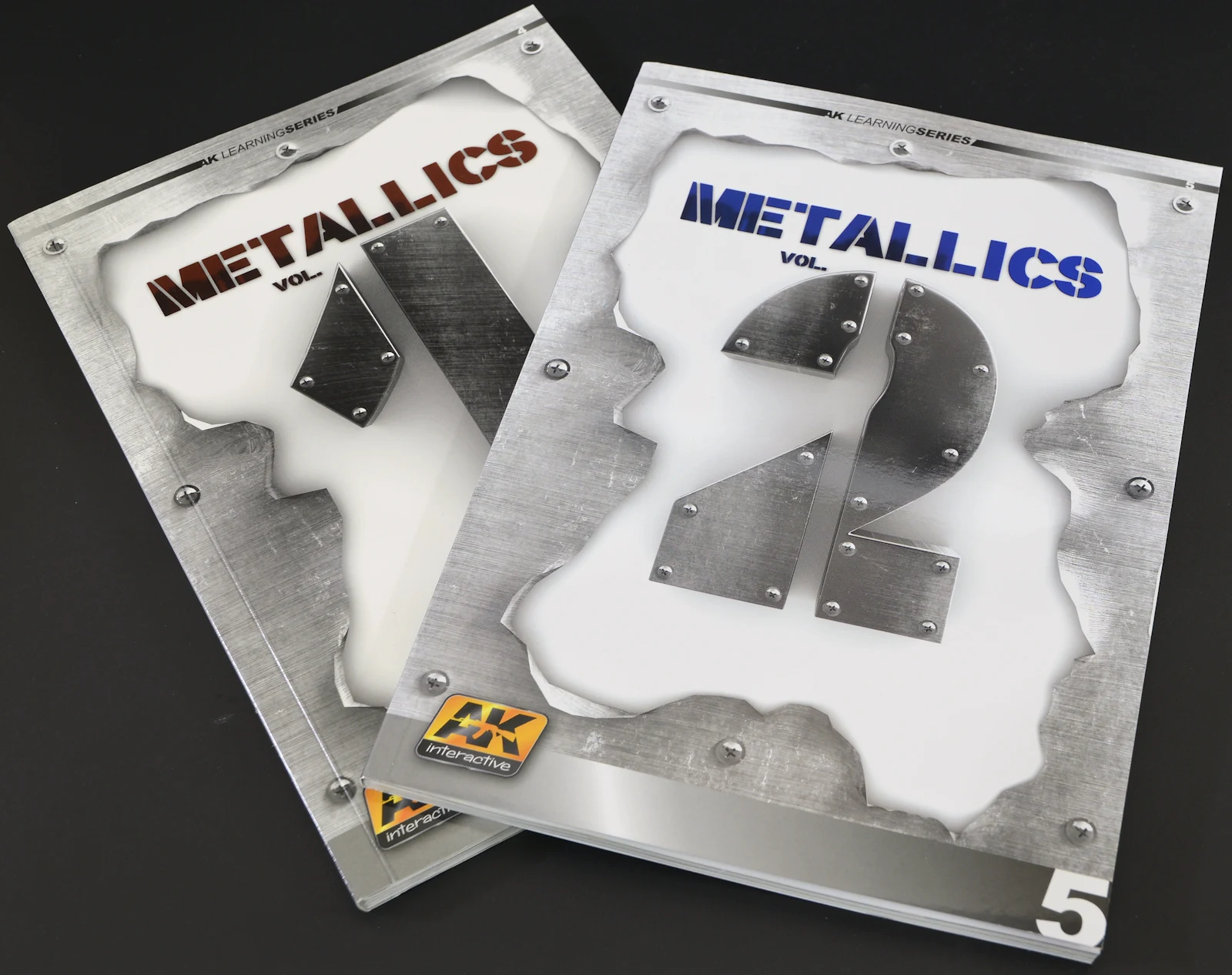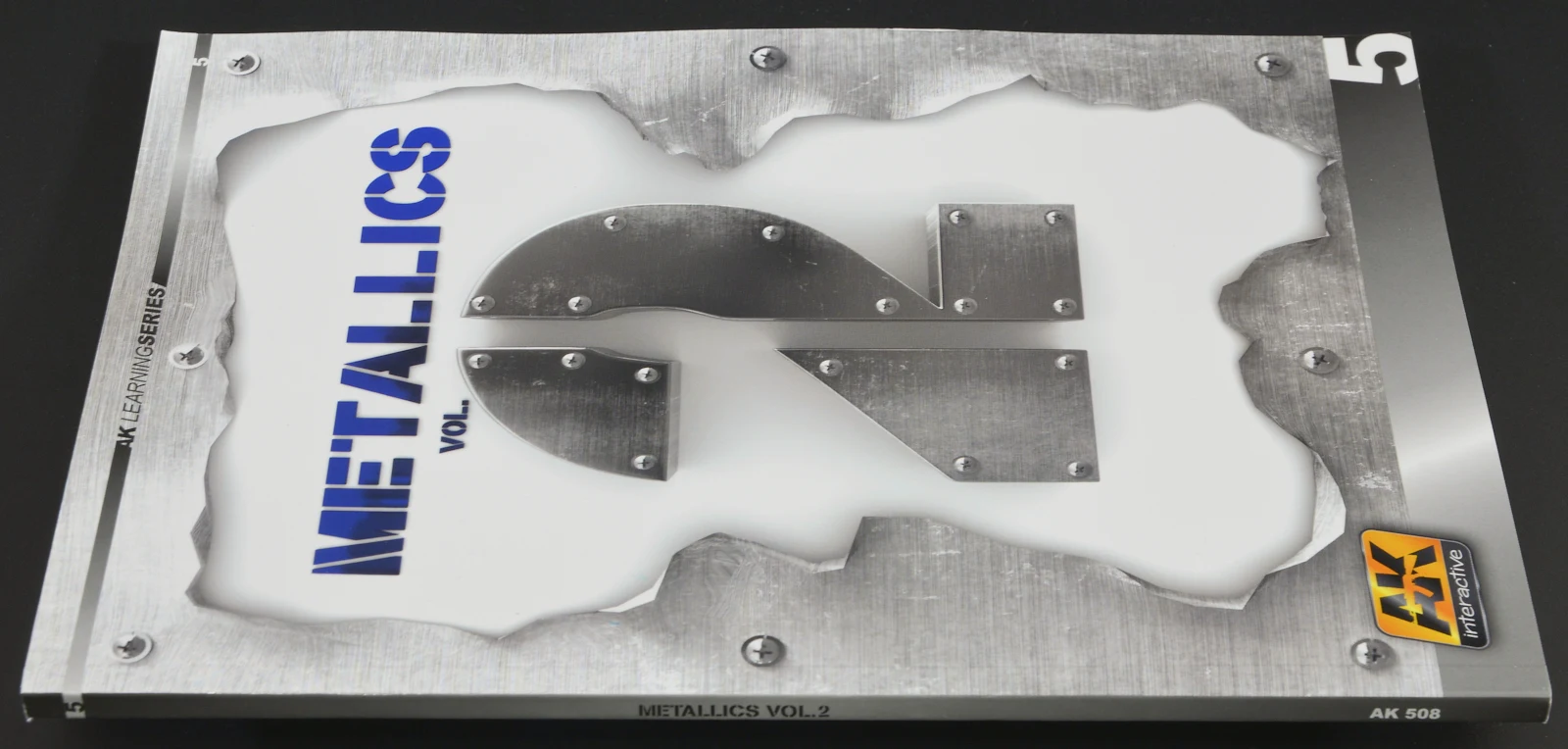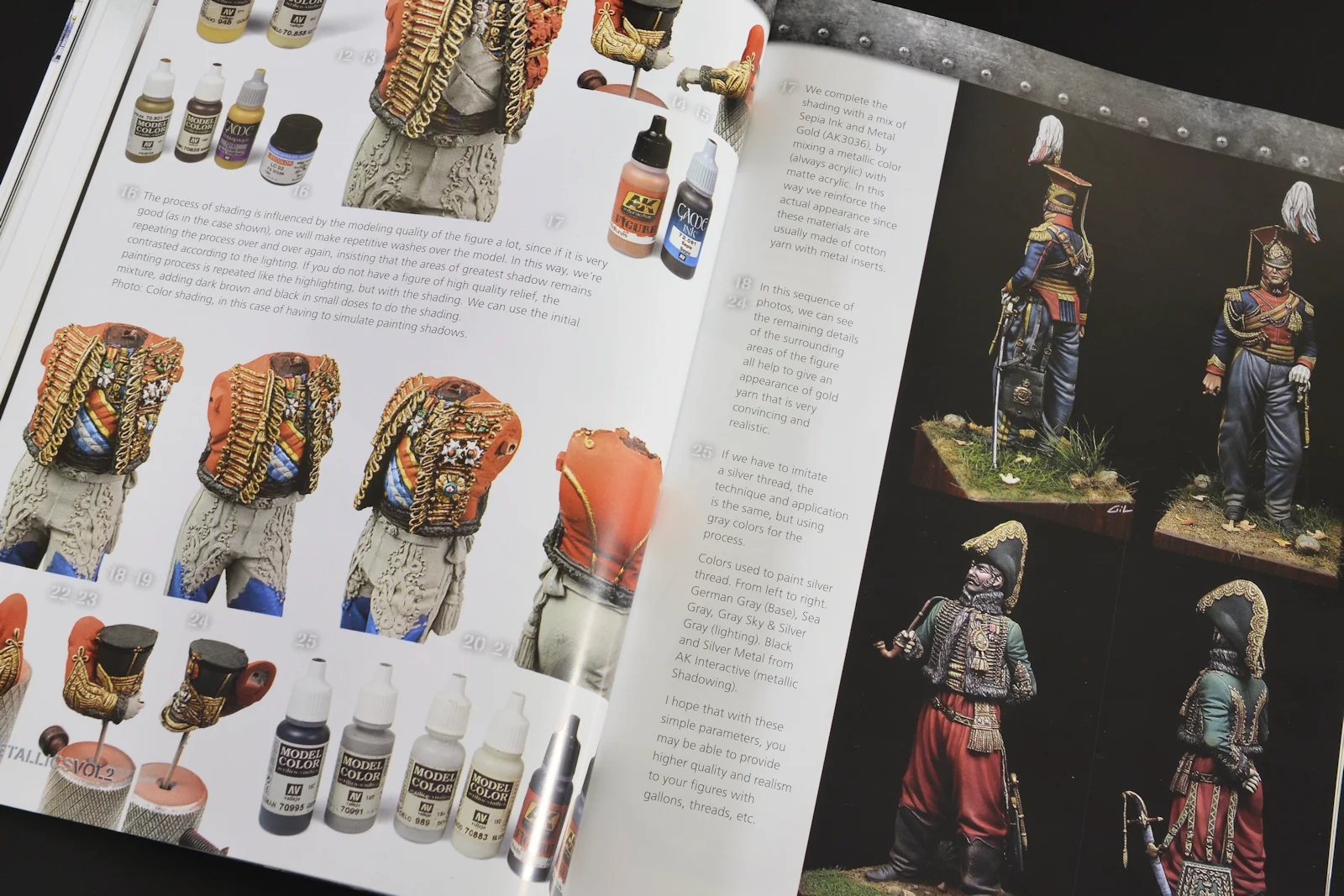
When I first saw these books from AK Interactive’s “Learning Range” I was very interested in them. Natural metal is one of the hardest things to reproduce with paint, powders and foil, so I thought reading them couldn’t do any harm. Let’s look at them both in a combined review to see if they polish our knowledge…
Read N’ Reviewed – Learning series Vol 4 & 5 from AK Interactive
Metallics Vol.1. Learning Series 04
Published by AK Interactive
Product no AK507
English version
84 pages
Price: 9,95 € directly from the AK Interactive website

Metallics Vol.2. Learning Series 05
Published by AK Interactive
Product no AK508
English version
87 pages
Price: 9,95 € directly from the AK Interactive website

Today we are offering a bit of “two in one” in our review of two of AK Interactive’s new books in the “Learning Series.” We are looking at both together because they are similar in format, layout and composition as well as the major subject which binds them. Today we look at “Metallics” Volume I & II.
To show you exactly what is similar and different about each of these, I will look at what is similar about these two, and then I will look at the parts and breakdown of each of the volumes in turn. Let’s find out if they shine or if they are just dull…
Physically…
Both of these two companion volumes are the same size and format. A portrait, softcover books, both in English language and both full of colour photos with text explaining each of the pictures. Volume I is 84 pages, whilst Vol. II is 87 pages. Both do not have one author per se – they have a bunch of modeller’s work compiled by Fernando Vallejo, who puts all of their excellent work into these combined volumes in the appropriate places.

Straight away the work in both of these books I will note is very attractive. It is also varied as we will see, with all genres of models, scales and types included, sometimes surprisingly so. I did not think I would see some of the subjects here included. This is not just for aircraft, armour or AFV guys – these books are aimed at anyone who wants to replicate any type of model.
Both of these books are a very good companion to both AK Interactive’s new metal paint and polish ranges. To say that these are instruction manuals for them is partially correct – as we see these, as well as many other methods of recreating metal on your workbench in these pages. I for one would like to see just how these paints perform so this was the second reason these books tweaked my interest.
OK enough beating around the bush – let’s look at each of them to tell you what’s inside.
Metallics Vol.1. Learning Series 04
Published by AK Interactive
Product no AK507
English version
84 pages
Price: 9,95 € directly from the AK Interactive website

Volume I “Metallics” is the fourth book in the “Learning Series” by AK Interactive. This book starts by giving us an intro, and then it gets very technical very fast. This is kind of the theory before you get to have the practical lesson. We learn about light, complimentary colours and how the light and colour effects they eye to give you different finishes of metals, from a mirrored look to an uneven and oxidised look.

This is a lot more of a complex subject than most people would appreciate, but here the simple way the text with pictures & diagrams is laid out makes this subject a lot easier to understand, and better than you probably ever had before.

We look at paint types next – enamels, acrylics and lacquers, as well as other applications to get you to the same place, graphite powder and pencils, pigments. generally, just a roundup of the products you can use.

Next, we look at the main types of metals found in out models we want to represent. Each page gives us a general overview of the composition and properties of each of the metals, how it ages and oxidises, as well as the main uses and working properties of each metal. The recommended paint to represent and age each of the metals is helpful. In all nine metals are documented: Iron, Steel, Aluminium, Copper, Bronze, Brass, Titanium, Chrome, Silver and Gold. This is an extensive list that I had to double check before I wrote it all down so I would not miss any of them. It’s a very good learning feature you can use to refresh your knowledge as long as the book is in easy reach.

We next look at how to weather our metal paints. A helpful table shows us the metallic replication of six types of paints, from Tamiya, Lara, Mr Metal Color, AK Xtreme Metal, Model air aluminium, and lastly Alclad. Great to see the variety of paints talked about (my big bugbear with paint supplier’s books in the past) which really makes me pay attention. We don’t all paint with one type of material and it’s great to see it reflected in the text. We look at painting, with wax and pigments, the example of a towing cable is shown on a double page spread.

We cut to a model from the talented Daniel Zamarbide next. He makes a very nice and variably textured Mirage III come alive with Xtreme Metal paints. The SBS (Step by Step) walkthrough of each picture, accompanied by text is a helpful tutorial here, It's good to see an experienced modeller take you through just how to get the best from a new paint that is still probably a mystery to some of us.

We see the same SBS treatment from Tomas De La Fuente next with his P-51 painted in Tamiya and Alclad shades. It’s also a great model and the six pages here hopefully show in brief how to get ‘er done.

Several ink paint (transparent paints) are then applied to engines to bring out those odd shades we see when heat of various types is put onto various metals. Again it’s very good to see different paints here- not just the publisher’s products.

Bare Metal foil is a mystery to some, and over the next six pages, we see how to apply it to a beautiful Jaguar E-type model, as well as the exhaust and base plate of a sci-fi model. This subject could well be expanded upon, but the tutorial in SBS is pretty informative.

Graphite pencils and metallic-flecked paints are next – with an example of a “mica” flecked GP bike (did I say that the variety of models was impressive?) This is one of the more impressive SBS builds in that there is more text. We see all of the metal on the bike (engine, wheels, etc) painted and weathered as well as the metallic paint on the bike.

One of the hardest aspects of painting metallics – that of recreating chrome – is covered next, with the Hunter Killer from Terminator movies modelled. We also look at weathering chrome, and lastly – abruptly we see some helpful tips on painting the bronze of ships propellers and other under-sea metallic creations.

On to Volume II.
Metallics Vol.2. Learning Series 05
Published by AK Interactive
Product no AK508
English version
87 pages
Price: 9,95 € directly from the AK Interactive website

The second book in this series is, like I said all but the same in proportions and makeup physically from the first volume on metallics. We still get a proper into and contents. The only real difference in feel is that this book is slightly more flexible than its companion. Weird I know, but mine was just that little bit more bendy. It does not affect the reading in any way, but this IS a review.

This volume is a lot more broken up into smaller sections than the first book on Metallics. I will be jumping a little from bit to bit to cover it, but I’ll explain in brief each part so you know exactly what’s inside.

The two real major paint types, those of Acrylic and enamel are talked about very briefly. The pros and cons of each and the preferred applications are discussed before we break into a chapter on the techniques you use to paint these to best replicate metal.

This technique chapter shows us how to make scale metal with metallic and non-metallic metal (NMM) paints. It might sound like the same thing, and in a way, the end result should be the same, but there is more than one way of reaching the end in this strive for a true metallic look.

Using citadel paints as a guide, there is a chart showing how to recreate highlights on figures and the metal they carry and wear. Each layer is shown, from the dark base right through to where the light reflects of the metal to your eye. It is thought evoking painting process and pretty successfully explained here. We see the effect on figure miniatures and a face painted up in several steps. The wearing and atmospheric effects on the face are shown also. It’s a really interesting walkthrough to me.

Non Metallic Metal (NMM) paints are shown more over the next fifteen or so pages. We look at plenty of varied examples of how the metal’s colours and shine change when the light reflects from it into the viewer’s eye. This technique is best represented when the model looks like this – from the one angle, the viewer is expected to see it from.
We have first been explained the theory behind it, the principles within of light incidence, contrast, and where to place shadows is talked about only briefly before we get straight into practical demonstrations with repetition in an SBS style showing a metal axe and that ugly face again. We look at the different shades of metal within this technique. Silvered, gold and bronzed metal is shown with the appropriate colours to shade them.

We also look at gold braid with two lovely Napoleonic (?) era figures next. The light and shadows are brought to the eye as the painter explains how the technique makes the non-metallic paint look like metal braid and uniform highlight. We do the same with Warhammer miniatures. First looking at NMM paints, then a mixture of NMM and Metallic paints and lastly at the use of white metal figures and how we can take advantage of that without the metal oxidising.

The beautiful and very effective method of dotting and stippling on the steel parts to recreate a worn and textured metal surface are next. Like NMM, this is a more artistic approach but a very cool tool to have in your arsenal. One I see more and more from some of the best modellers.

The advance Bluing technique is next. We are explained in a few SBS’s how to use the airbrush stippling paint over the kit in layers, with gradual lightening and in the right shades to do this in silver and then gold with an extended SBS showing a resin C-3PO. The SBS is extensive and on both of these kits really informative to the reader.

Lastly we see examples of some of the paints in this series in action. We see the Xtreme metal painting system on this T-800 model – this is always good to see weathered and textured rather than in just straight chrome. We also see the modern (yawn) Cylon and the raider space ship painted with the same paint, but with different weathering techniques, each bringing quite a different outcome.

Two last examples are in a darker shade of metal. A large armoured figure with an extended building tutorial as well as a painting SBS with lastly some simple painting techniques shown on a Bio-shock toy that is re-painted here to a great effect. An odd choice to end on – but it does look good none the less.

SO in summary – I can say that each of these books will be helpful to modellers. Whilst the first book hangs a little more on theory which you could expect, and the modelling is more traditional.

The second book focusses much more on the advanced techniques of figure and fantasy modellers. This one is more enlightening to me because I have learned a little more from it.

The two books together, for me, would be the choice I would take. The fact that both of them cover everything you pretty much need to know, the fact that they use many different methods and paint types to make a metal look. Lastly the fact that both of them cost 20 Euros in total. Really it is a bit of a no-brainer really isn’t it?
A great pair of books that taught me a lot.
Adam Norenberg
Thanks to AK Interactive for sending these two books to us to read and review. Both are available from AK Interactive’s website & Distributors Worldwide

